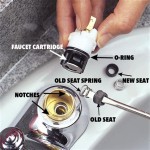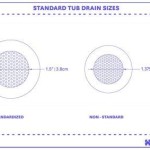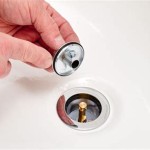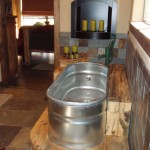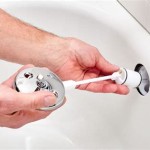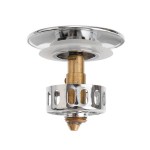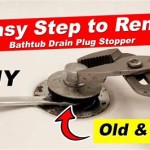Bathtub Sewer Cleanout: A Comprehensive Guide
The bathtub, a sanctuary for relaxation and hygiene, can quickly become a source of frustration when drainage issues arise. Slow draining or completely clogged bathtubs are common plumbing problems, often stemming from the accumulation of hair, soap scum, and other debris within the drainpipe. While minor clogs can sometimes be resolved with a plunger or over-the-counter drain cleaner, more significant blockages necessitate a more thorough approach. Understanding the bathtub sewer cleanout, its location, function, and how to utilize it, is crucial for effective plumbing maintenance and resolving complex drain problems.
A sewer cleanout is a designated access point within a plumbing system that allows for the insertion of tools and equipment to clear obstructions. In the context of a bathtub, the cleanout provides direct access to the drainpipe leading away from the tub, making it possible to reach and remove blockages that are situated further down the line than a standard plunger can reach. The presence and accessibility of a bathtub sewer cleanout can significantly simplify the process of clearing a clogged drain, preventing the need for more invasive and costly plumbing repairs.
It's important to distinguish between a standard bathtub drain and a sewer cleanout. The drain is the visible opening at the bottom of the tub where water flows out. The cleanout, on the other hand, is a separate access point, typically located outside of the tub itself. Its design facilitates the insertion of plumbing snakes or other tools without requiring disassembly of the bathtub drain assembly.
Identifying the Bathtub Sewer Cleanout Location
Locating the bathtub sewer cleanout can sometimes require a bit of investigative work, as its placement can vary depending on the age of the building, the plumbing layout, and local building codes. The most common locations for a bathtub sewer cleanout are behind an access panel in the wall adjacent to the bathtub, beneath the bathtub itself, or in the basement or crawlspace directly below the bathroom. The access panel, if present, is typically a small, rectangular door that can be removed or unscrewed to reveal the plumbing behind the wall. If the access panel is absent, careful inspection of the surrounding walls, particularly those near the bathtub's drainpipe, may be necessary.
If the cleanout is located beneath the bathtub, access can be gained by removing an access panel, if one exists, or by carefully removing a section of the floor near the bathtub. This option often requires more extensive work and may not be feasible in all situations. In some older homes, the cleanout may be located in the basement or crawlspace. In this case, it will typically be situated on the main drain line leading from the bathroom, identifiable by its proximity to the bathtub's drainpipe configuration.
The cleanout itself usually consists of a capped pipe fitting, often made of PVC or metal, with a square or hexagonal head for wrenching. The cap is designed to be removed, providing access to the inside of the drainpipe. In some cases, the cleanout may be concealed behind a plaster or drywall covering. If this is the case, carefully cutting away the covering around the pipe fitting will reveal the cleanout. Exercise caution when cutting into walls, ensuring that no electrical wiring or other plumbing is damaged in the process.
If the cleanout cannot be located in any of the aforementioned areas, consulting the building's blueprints or contacting a professional plumber may be necessary. A plumber can use specialized tools and techniques to locate hidden cleanouts or determine the best alternative access point for clearing the drain.
Using the Bathtub Sewer Cleanout to Clear a Clog
Once the bathtub sewer cleanout has been located, the process of clearing the clog can begin. It is advisable to wear gloves and eye protection during this process, as sewer lines can contain bacteria and other contaminants. It is also a good idea to have towels or rags on hand to clean up any spills that may occur.
The first step is to carefully remove the cleanout cap. Use a wrench or pliers to loosen the cap, turning it counterclockwise. Be prepared for some water to drain out of the pipe when the cap is removed, as there may be standing water in the drainpipe. Place a bucket or container beneath the cleanout to catch any water that spills out.
After removing the cap, the blockage needs to be dislodged or extracted. A plumbing snake, also known as an auger, is the most common tool used for this purpose. A plumbing snake is a flexible metal cable with a corkscrew-shaped tip that is designed to be inserted into the drainpipe and used to break up or retrieve clogs. Insert the snake into the cleanout opening and feed it down the drainpipe, rotating it as you go. Continue feeding the snake until you encounter resistance, indicating that you have reached the clog. Once you reach resistance, continue to rotate the snake to break up the clog or to hook onto it. If the clog is made up of hair or other debris, the snake may be able to hook onto it and pull it out. If the clog is more solid, such as a soap scum buildup, the snake may need to be used to break it up into smaller pieces that can be flushed down the drain.
Periodically remove the snake from the drainpipe to clean off any debris that has been collected. This will help to prevent the snake from becoming stuck in the drainpipe. After you have removed a significant amount of debris, flush the drain with hot water to help clear out any remaining particles. Repeat this process until the drain is flowing freely.
If a plumbing snake is not available, alternative methods can be used to clear the clog. A wet/dry vacuum can be used to suck out debris from the drainpipe. Place the vacuum hose over the cleanout opening and create a tight seal. Turn on the vacuum and allow it to run for several minutes. The suction from the vacuum may be enough to dislodge the clog. Another method is to use a garden hose to flush out the drainpipe. Insert the hose into the cleanout opening and turn on the water. The force of the water may be enough to dislodge the clog.
Once the drain is flowing freely, replace the cleanout cap and tighten it securely. Run water into the bathtub to ensure that the drain is working properly. If the drain is still slow or clogged, repeat the process. If the problem persists despite repeated attempts, it is advisable to consult a professional plumber.
Preventive Measures to Avoid Future Clogs
Preventing future clogs in the bathtub drain is essential for maintaining a smoothly functioning plumbing system. Implementing a few simple preventative measures can significantly reduce the likelihood of drain blockages and the need for frequent cleanouts.
One of the most effective preventative measures is to install a drain strainer or screen over the bathtub drain. This will catch hair, soap scum, and other debris before they enter the drainpipe. Regularly clean the strainer or screen to remove any accumulated debris. This can be done easily with a small brush or by simply rinsing it under running water.
Avoid using excessive amounts of soap or shampoo when bathing or showering. Excess soap can contribute to the buildup of soap scum in the drainpipe. Use only the amount of soap or shampoo that is necessary to get the job done. Consider using liquid soaps and shampoos, as they tend to produce less soap scum than bar soaps.
Periodically flush the drainpipe with hot water. Hot water can help to dissolve soap scum and other debris that may be accumulating in the drainpipe. Run hot water down the drain for several minutes after each bath or shower. Alternatively, pour a kettle of boiling water down the drain once a week. Exercise caution when using boiling water, as it can damage some types of pipes.
Baking soda and vinegar can be used to clean and deodorize the drainpipe. Pour one cup of baking soda down the drain, followed by one cup of vinegar. Allow the mixture to fizz and bubble for 30 minutes, then flush the drain with hot water. This combination can help to break down soap scum and other debris, as well as neutralize odors.
Avoid pouring grease or oil down the drain. Grease and oil can solidify in the drainpipe, leading to clogs. Dispose of grease and oil properly by collecting it in a container and discarding it in the trash.
By implementing these preventative measures, homeowners can significantly reduce the risk of bathtub drain clogs and maintain a healthy plumbing system. Regular maintenance is key to avoiding costly repairs and ensuring the longevity of the plumbing infrastructure.

Top 5 Tips On How To Unclog A Bathtub Drain Smiley Cleaning

5 Easy Ways To Unclog Bathtub Drain

4 Ways To Clean A Bathtub Drain Wikihow

How To Unclog Bathtub Drain Pipes Save 200 In Two Minutes

Why Is There Sewage Coming Through The Bathtub Drain

How To Unclog A Bathtub Drain Without Chemicals

Sewage Coming Up Through Your Bathtub What To Do

How To Unclog A Bathtub Drain Without Chemicals Family Handyman

4 Ways To Clean A Bathtub Drain Wikihow

Sewage Coming Up Through Your Bathtub What To Do
Related Posts


